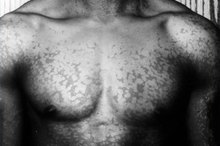How to Know if Ringworm Is Dying
Despite its name, ringworm is actually a type of fungus. This fungus causes skin infections and irritations, such as redness, scaly patches, itchiness, and bald spots. It is called ringworm because the red irritation often looks like a red ring on the skin. Ringworm is contagious and easily passed between people through touch. Pets that are infected with ringworm can also pass the fungus to other pets or people. Although this infection can be uncomfortable and embarrassing, ringworm is treatable, and when the fungus is dying, you will be able to see a noticeable change in your health 1.
If you are experiencing serious medical symptoms, seek emergency treatment immediately.
Look closely at the infected area after you’ve been treating it for a few days. Try to remember what it looked like before you began treating it, and compare it to what it looks like now. Note the red coloring. In active ringworm infections, the infected area is often bright red. If, over the course of treatment, you notice that the color is returning to your natural skin color, you can be reasonably certain that the ringworm is dying. If the ringworm has infected your nails, they may also be discolored. A return to a healthy nail color also means that the ringworm is dying.
What Happens If Ringworm Is Untreated?
Learn More
Judge how itchy the affected area is. Ringworm infections often cause a lot of itching. If your skin feels less itchy, the ringworm is probably dying.
Watch for a change in the moisture level of the skin. Some ringworm infections create a weeping sore, which will begin to dry and flake as it heals. However, other ringworm infections cause scaly patches. As the ringworm dies, these patches will dissipate. Try to remember whether your infection was moist or dry before you began treating it in order to judge whether the ringworm is dying.
How to Use Bleach to Cure Ringworm
Learn More
Observe the amount of swelling in the infected area. Swelling is a common symptom of ringworm. A reduction in swelling is a good sign that the treatment is working and the ringworm is dying 2.
Look for hair re-growth. Ringworm often causes bald patches if it infects an area covered by hair. New hair growth will be easier to spot if the infected area is on your head, or the fur of an animal, but if the infection occurred on an arm or leg, you may also be able to spot new hair growth. This hair growth means that the ringworm is no longer affecting that area, and is dying.
Tips
Although ringworm may show signs of dying before the treatment is complete, it’s important to continue treating the infection for as long as prescribed, in order to make sure that it is completely gone.
Related Articles
References
- Google Health: Ringworm
- Ringworm Treatments: Positive Signs Showing that the Ringworm is Healing
- My Cute Dogs: Signs that Ringworm Is Healing
- Homei A, Worboys M. Fungal Disease in Britain and the United States 1850–2000: Mycoses and Modernity. Basingstoke (UK): Palgrave Macmillan; 2013. Chapter 1, Ringworm: A Disease of Schools and Mass Schooling. Available from: https://www.ncbi.nlm.nih.gov/books/NBK169210/
- Jain A, Jain S, Rawat S. Emerging fungal infections among children: A review on its clinical manifestations, diagnosis, and prevention. J Pharm Bioallied Sci. 2010;2(4):314–320. doi:10.4103/0975-7406.72131
- Yee G, Al Aboud AM. Tinea Corporis. [Updated 2019 Jul 6]. In: StatPearls [Internet]. Treasure Island (FL): StatPearls Publishing; 2019 Jan-. Available from: https://www.ncbi.nlm.nih.gov/books/NBK544360/
- Alkeswani A, Duncan JR, Theos A. Tinea faciei starting at day two of life. Pediatr Dermatol. 2019;36(1):e20-e22.
- Furlan KC, Kakizaki P, Chartuni JC, Valente NY. Sycosiform tinea barbae caused by trichophyton rubrum and its association with autoinoculation. An Bras Dermatol. 2017;92(1):160–161. doi:10.1590/abd1806-4841.20174802
- Hay RJ. Tinea Capitis: Current Status. Mycopathologia. 2017;182(1-2):87–93. doi:10.1007/s11046-016-0058-8
- InformedHealth.org [Internet]. Cologne, Germany: Institute for Quality and Efficiency in Health Care (IQWiG); 2006-. Athlete's foot: Overview. 2015 Jan 14 [Updated 2018 Jun 14].Available from: https://www.ncbi.nlm.nih.gov/books/NBK279549/
- Nadalo D, Montoya C, Hunter-smith D. What is the best way to treat tinea cruris?. J Fam Pract. 2006;55(3):256-8.
- Das S, Barbhuniya JN, Biswas I, Bhattacharya S, Kundu PK. Studies on comparison of the efficacy of terbinafine 1% cream and butenafine 1% cream for the treatment of Tinea cruris. Indian Dermatol Online J. 2010;1(1):8–9. doi:10.4103/2229-5178.73249
- Errichetti E, Stinco G. Dermoscopy in tinea manuum. An Bras Dermatol. 2018;93(3):447–448. doi:10.1590/abd1806-4841.20186366
- Piraccini BM, Alessandrini A. Onychomycosis: A Review. J Fungi (Basel). 2015;1(1):30–43. Published 2015 Mar 27. doi:10.3390/jof1010030
- Ashraf M, Biswas J. Chronic ringworm infestation and Marjolin's ulcer, an association unknown in the literature. Rare Tumors. 2010;2(2):e31. Published 2010 Jun 30. doi:10.4081/rt.2010.e31
- Landry GL, Chang CJ, Mees PD. Treating and avoiding herpes and tinea infections in contact sports. Phys Sportsmed. 2004;32(10):43-4.
- Davis EC, Callender VD. Postinflammatory hyperpigmentation: a review of the epidemiology, clinical features, and treatment options in skin of color. J Clin Aesthet Dermatol. 2010;3(7):20–31.
- Fuller LC, Child FJ, Midgley G, Higgins EM. Diagnosis and management of scalp ringworm. BMJ. 2003;326(7388):539–541. doi:10.1136/bmj.326.7388.539
- Boral H, Durdu M, Ilkit M. Majocchi's granuloma: current perspectives. Infect Drug Resist. 2018;11:751–760. Published 2018 May 22. doi:10.2147/IDR.S145027
- Al Aboud AM, Crane JS. Tinea Capitis. [Updated 2019 Mar 2]. In: StatPearls [Internet]. Treasure Island (FL): StatPearls Publishing; 2019 Jan-. Available from: https://www.ncbi.nlm.nih.gov/books/NBK536909/
- Ely JW, Rosenfeld S, Seabury stone M. Diagnosis and management of tinea infections. Am Fam Physician. 2014;90(10):702-10.
- “Ringworm: Signs and Symptoms.” American Academy of Dermatology, American Academy of Dermatology.
- Laniosz V, Wetter DA. "What's New in the Treatment and Diagnosis of Dermatophytosis?" Seminars in Cutaneous Medicine and Surgery. 2014 Sep;33(3):136-9.
Tips
- Although ringworm may show signs of dying before the treatment is complete, it's important to continue treating the infection for as long as prescribed, in order to make sure that it is completely gone.
Writer Bio
Ann LaPan travels exuberantly in body and mind via planes, trains, automobiles and superb literature. A webmaster, website designer, graphic artist, accountant and musician (Jill of all trades, master of a few), she writes Today’s Horoscope for Shooting Star Astrology.com.








